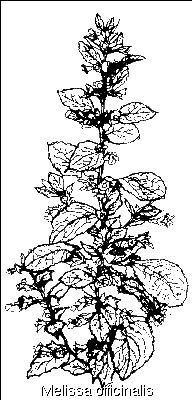LEMON BALM
(Melissa officinalis)

Appearance
An erect perennial with slightly downy lemon scented
leaves. Whitish flowers tinged lilac in a lax flower head appear from May
to September.
Habitat
Found in open rock-rose garigue, by roadsides or on cultivated
ground, but mostly in damp thickets or by stream sides from sea-level to
4,500 ft.
Uses and Properties
Extracts from lemon balm are said to have stimulant,
digestive and sedative properties, and to act as a tonic for the heart,
brain and peptic system. Lemon balm tea is reputed to have blood pressure
normalising properties. In cooking, lemon balm is used for stuffings and in
egg dishes. Though the flower tubes of lemon balm are too long to allow
bees to forage, bees find a paste made from crushed leaves
irresistible. A swarm of bees can be attracted to a convenient locate by
smearing such a paste onto an object. Rubbing the hands with lemon balm
prevents bees from stinging. A strong decoction of fresh leaves, either
with other herbs or on its own adds a lovely fragrance to bath water. An
infusion of lemon balm soothes and softens irritations of the skin and
smooths wrinkles. Juice of leaves for bites. Dried leaves in pot-pourri.




